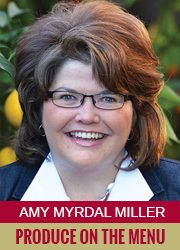This is the third of a three-part series looking at the unique challenges both small and large foodservice operations face in getting product into their operation.
 Last month I gave insights from chefs working for major volume foodservice operations on what they want from their produce suppliers. This month, I’m focusing on recommendations for selling produce to foodservice buyers. These insights are based on conversations I’ve had with buyers from a variety of foodservice operations, including campus dining operations and large chains, as well as buyers for large contract foodservice organizations.
Last month I gave insights from chefs working for major volume foodservice operations on what they want from their produce suppliers. This month, I’m focusing on recommendations for selling produce to foodservice buyers. These insights are based on conversations I’ve had with buyers from a variety of foodservice operations, including campus dining operations and large chains, as well as buyers for large contract foodservice organizations.
I mentioned last month, there are two themes that run through all comments I receive — communication and collaboration. Chefs want this, and so do their buyers.
Build Relationships
Nobody really wants to be sold, but most everyone wants to enjoy the process. Events like the PMA Foodservice Conference show the power of the relationship. More time is spent on field and facility tours and at local golf courses than in sessions or the exhibit halls. This is because great produce companies and their sales team know it’s important to build relationships with the people making purchasing decisions. We all like doing business with people we know and trust. Think about what more you can do to enhance relationships with the foodservice buyers.
Provide Experiences
A golf outing is great for building the relationship — you get to know your customer’s kids’ names, where they vacation, and you can start joking about each other’s golf swings … or misses — but a field tour is much more powerful. The bottom line is that showing is always better than telling.
Can you make the buying process easier by clarifying the specification process?
Show the buyers you work with how you grow the product. I’m always shocked by how many chefs and buyers tell me they’ve never been in a field or orchard. People who work with or buy the product every day may have very little understanding of how you grow, pack and ship produce.
Walk the buyers through the rows. Talk about crop inputs like irrigation or crop protection products. Show them how you work to ensure food safety. Invite them to talk with your farmers, field workers and harvest crews. Talk about harvest and packing innovation. Walk them through your packing houses, cold storage environments and distribution centers.
Don’t hesitate to talk about the challenges of growing your product given climate change, water shortages, new threats to yield and quality, and how you’re dealing with the challenges from Mother Nature and beyond. Growing, packing and shipping produce is not easy, and your customers need to know how you’re dealing with endless challenges to bring safe, high-quality produce to market.
Do you work with a seed company developing new varieties for your operation? Take your customers on tours of the seed company’s operation. Does your vendor offer field days? Ask if you can invite customers to join you so you can all see the new varieties, talk to the breeders and most importantly, taste new varieties you may be able to bring to market in the future.
Sell Solutions
While it may seem like all buyers want is to snag the lowest cost, most are very interested in products that help them and their operation solve challenges. I’ve talked extensively about the labor challenges in foodservice. If you have an idea for, or are already offering, a new value-added product, talk to the buyer about this option. He/she may be eager to help the operations team reduce labor costs.
Do you have options for increasing shelf-life? If so, talk to your customers about these innovations. Decreasing delivery frequency may be a benefit for certain operations, and reducing food waste is a benefit for every organization.
Can you make the buying process easier by clarifying the specification process? Do you have visual guides to help a buyer specify degrees of ripeness? Can you specify if your product is harvested at a certain brix level? Can you help buyers identify which produce items may be genetically modified and which are developed only through traditional or advanced breeding techniques? Confusion over GMOs in produce is making the lives of some buyers quite complicated right now.
Finally, can you provide lower-cost product by selling the foodservice buyer “ugly” fruits and vegetables? Foodservice doesn’t need perfect produce. If you have great quality in terms of flavor, but challenges with appearance, talk to buyers about special pricing.
Amy Myrdal Miller, MS, RDN, FAND is a farmer’s daughter from North Dakota, award-winning dietitian, culinary nutrition expert, and founder and president of Farmer’s Daughter Consulting, Inc. She is the director of The Culinary Institute of America Healthy Menus R&D Collaborative. You can learn more about her business at farmersdaughterconsulting.com, and you can follow her insights on food and flavor on Twitter @AmyMyrdalMiller.



